The Smith's St. Leonard Fan
March 2012
By Alex Glass, MAC Lab Public Archaeology Asst.
During the 2011 excavations at the Smith's St. Leonard site, located at Jefferson Patterson Park and Museum, archaeologists worked to excavate a kitchen cellar that had been filled with trash and then covered with a brick surface. The cellar artifacts appear to date from the middle of the 18th-century. Because of this, it is possible the cellar could have been filled in around 1748, when the property changed hands several times due to deaths in the Smith family (Fig.1). Among the rubble and shell that filled a stratum layer roughly halfway down through the feature were the remains of an ivory hand fan.
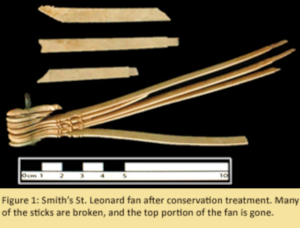 |
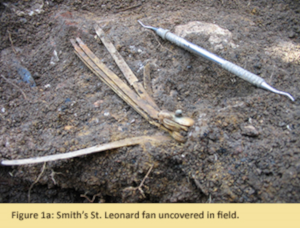 |
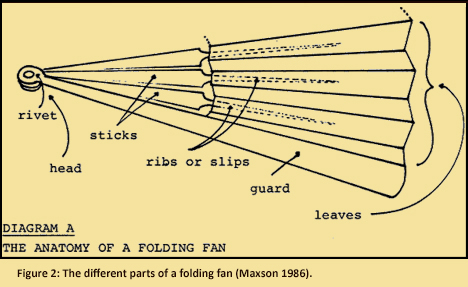 The Smith's St. Leonard fan is missing the paper section at its end that made the fan able to move air. This section is called the "leaf" (Webber 1984). It can be assumed that the paper or fabric decomposed over time, but because it seems likely the fan was broken when discarded, it is also possible that the leaf was removed. Some of the sticks (the thin pieces of ivory attached by a rivet at the lower end of the fan) are broken, and the ribs which attached the leaf to the sticks have either broken off or decomposed. A complete copper alloy rivet holds the sticks together so they can be spread apart or closed. While the ends of these rivets are sometimes decorated with a gem or paste stone, the Smith one is plain (Bradfield 1997). The sticks are mostly undecorated, and do not have any gilding, paint or inlays on them as some 18th century fans had. The bases of the sticks are carved with an "S"- like pattern. This pattern creates areas between the sticks when open, adding to the overall decoration of the fan (Fig. 2).
The Smith's St. Leonard fan is missing the paper section at its end that made the fan able to move air. This section is called the "leaf" (Webber 1984). It can be assumed that the paper or fabric decomposed over time, but because it seems likely the fan was broken when discarded, it is also possible that the leaf was removed. Some of the sticks (the thin pieces of ivory attached by a rivet at the lower end of the fan) are broken, and the ribs which attached the leaf to the sticks have either broken off or decomposed. A complete copper alloy rivet holds the sticks together so they can be spread apart or closed. While the ends of these rivets are sometimes decorated with a gem or paste stone, the Smith one is plain (Bradfield 1997). The sticks are mostly undecorated, and do not have any gilding, paint or inlays on them as some 18th century fans had. The bases of the sticks are carved with an "S"- like pattern. This pattern creates areas between the sticks when open, adding to the overall decoration of the fan (Fig. 2).
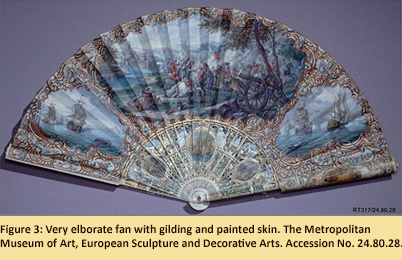 Hand fans have been in use for hundreds of years, but were introduced to Europe later in the 13th and 14th centuries from Asian countries through trade (Steele 2002). Fans gained widespread popularity in Europe during the next several centuries and, by the 18th century, fan-makers were producing highly elaborate and detailed fans. These could be commissioned by wealthy ladies of the period and often were made of precious materials such as ivory, mother of pearl, exotic woods and fine fabrics or animal skins (Mayor 1980). Many fans featured hand painted paper or silk leaves with scenes that depicted military accomplishments, maps, dance steps, biblical scenes, and landscapes (Fig. 3).
Hand fans have been in use for hundreds of years, but were introduced to Europe later in the 13th and 14th centuries from Asian countries through trade (Steele 2002). Fans gained widespread popularity in Europe during the next several centuries and, by the 18th century, fan-makers were producing highly elaborate and detailed fans. These could be commissioned by wealthy ladies of the period and often were made of precious materials such as ivory, mother of pearl, exotic woods and fine fabrics or animal skins (Mayor 1980). Many fans featured hand painted paper or silk leaves with scenes that depicted military accomplishments, maps, dance steps, biblical scenes, and landscapes (Fig. 3).
In comparison to some of these fancier fan types, the Smith's St. Leonard fan seems plain. Possibly, most of the decoration had been on the leaf, which is now gone. The sticks also could have been painted at one point, but there is no longer any residue from paint or gilding. It is hard to get an impression of what the fan may have looked like while it was in use, but its presence, along with the other artifacts in the cellar, provides for a deeper understanding of the Smith Family (Fig 4 and 5).
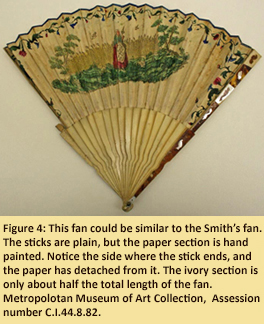 |
 |
| References |
|
| Bradfield, Nancy |
| 1997 |
Costume in Detail: 1730-1930. New York. Costume and Fashion Press. |
|
| Maxson, Holly |
| 1986 |
"Design and Construction of a Support for a Folding Fan" Book and Paper Group Annual. Vol. 5. http://cool.conservation-us.org/coolaic/sg/bpg/annual/v05/bp05-04.html, Page accessed 29 February 2012. |
|
| Mayor, Susan |
| 1980 |
Collecting Fans. New York. Mayflower Publishing. |
|
| Metropolitan Museum of Art |
|
Fan, 18th century. European. http://www.metmuseum.org/Collections/search-the-collections/80053870?rpp=20&pg=14&ft=fan&when=A.D.+1600-1800&what=Fans&pos=276, Page accessed 28 February 2012. |
|
| Metropolitan Museum of Art |
|
Fan, 1760-1750. Dutch (?). http://www.metmuseum.org/Collections/search-the-collections/120026309?rpp=20&pg=1&ft=24.80.28&pos=1, Page accessed 28 February 2012. |
|
| Steele, Valerie |
| 2002 |
The Fan: Fashion and Femininity Unfolded. New York. Rizzoli International Publishing. |
|
| The Art Institute of Chicago |
|
Abigail Chesebrough (Mrs. Alexander Grant), 1754, Joseph Blackburn American Art Gallery 166, http://www.artic.edu/aic/collections/artwork/102777, Page accessed 28 February 2012. |
|